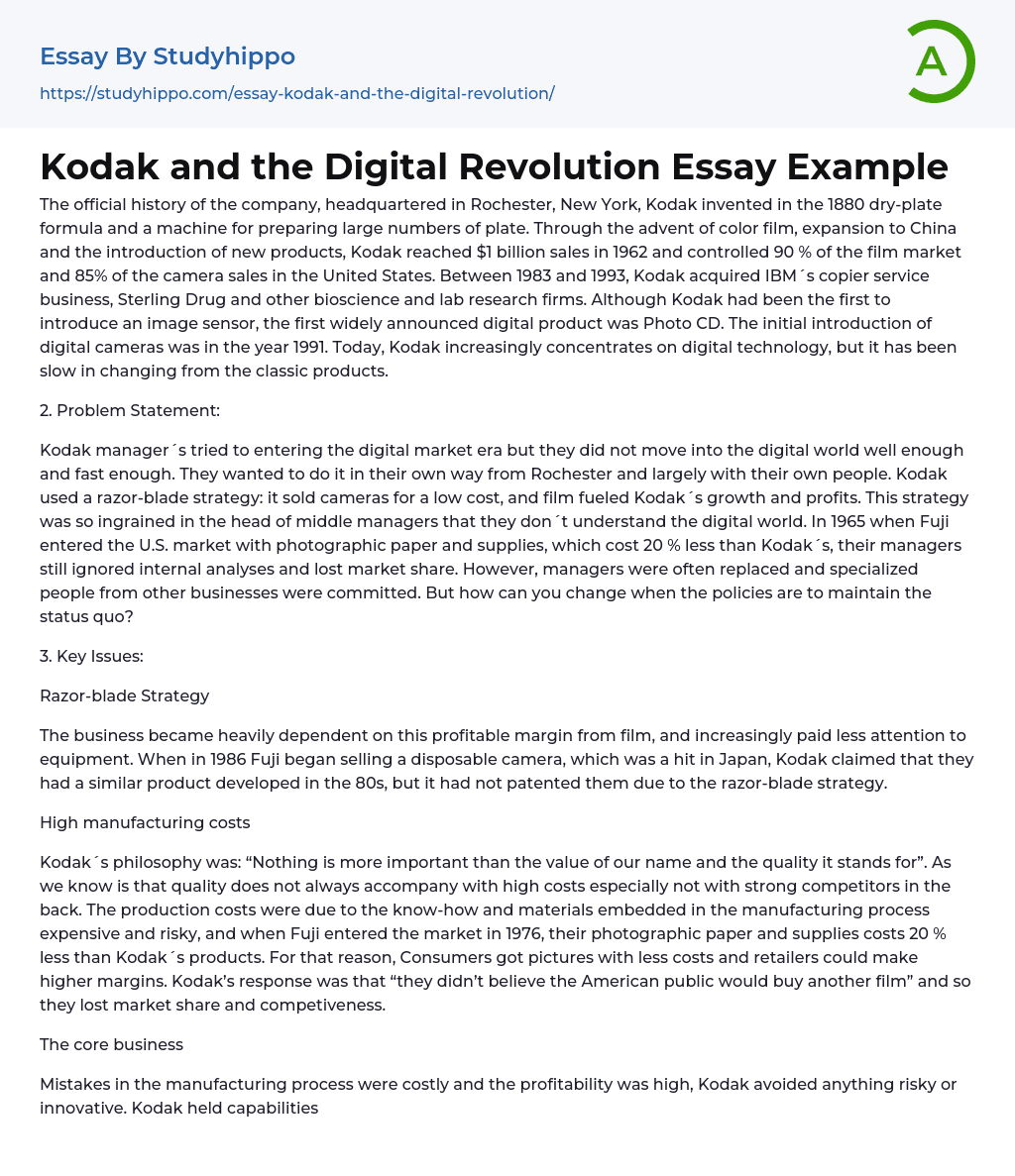Established in the late 1880s, Kodak is a colossal corporation headquartered in Rochester, New York. It made significant strides with its invention of the dry-plate formula and related mass production machinery. The company notched notable accomplishments including launching color film, entering the Chinese market, and rolling out groundbreaking products. In 1962, Kodak's sales hit an impressive $1 billion mark while dominating 90% share of the film market and holding 85% stake in camera sales within America. From 1983 to 1993, Kodak expanded its portfolio by acquiring IBM's copier service business along with Sterling Drug and multiple bioscience & lab research firms. Despite being at the forefront of image sensor technology innovation, their first widely advertised digital product was the Photo CD. They ventured into digital cameras segment in 1991. Nowadays, although Kodak is gradually shifting towards embracing digital techno
...logies more fully,the move away from traditional products has been comparatively slow-paced.
2. Statement of Issue:
During the advent of the digital era, Kodak's leadership faced challenges in successfully transitioning into the digital sphere. Their attempts to navigate this shift primarily from their Rochester base and using mostly their own staff proved inefficient and slow-paced. Kodak's commercial approach was akin to a razor-blade model where they sold cameras affordably while revenue and growth were propelled by film sales. A number of mid-level managers struggled to adjust to the new digital environment as they had deeply ingrained this business model. In 1965, when Fuji launched photographic paper and supplies in the U.S. market, priced 20% lower than Kodak's, the company overlooked internal assessments resulting in loss of market share. Despite periodically changing executive
and bringing onboard specialists from various sectors, effecting change was tough due to existing policies favoring status quo preservation.
3. Principal Concerns:
Strategy of Razor-blade
Kodak's business heavily leaned towards the substantial profits from film, thereby neglecting equipment. In 1986, when Fuji introduced a disposable camera which became very popular in Japan, Kodak asserted that they had developed a comparable product during the '80s. However, they hadn't patented it owing to the razor-blade strategy.
Elevated production expenses
Kodak adhered to the belief that “nothing carries greater weight than the reputation of our brand and the standard it represents”. Known for its high-quality products, Kodak demonstrated that top-notch quality does not necessarily correlate with high expenses, particularly in a market stiff with rivalry. The expenses involved in product manufacture, due to both knowledge and material inputs, were considerable and fraught with risk. In 1976, when Fuji penetrated the marketplace, their photography paper and associated supplies were priced 20% lower than Kodak's offerings. Consequently, customers could purchase images at lower prices and vendors could enjoy amplified profits. Kodak's reaction to this change was a presumption that American consumers will refrain from purchasing another brand of film. This mindset resulted in a loss of market dominance and competitiveness for Kodak.
The central enterprise
Due to expensive errors in their production process while making substantial profits, Kodak steered clear of any innovational or daring ventures. Kodak's expertise lay in film and paper, chemicals, and photo processing. However, the digital age was dependent on technology. Additionally, even though Kodak's Chief Executive Officer accepted that the advent of the digital period needed quicker
actions from Kodak, he continued to believe in a future dominated by silver-halide.
Variations in management and expertise
The inconsistency in Kodak's leadership greatly affected its strategy, as it fluctuated with the introduction of each subsequent chief executive. Despite them having almost identical training, their belief in the less profitable digital world over traditional film varied. Consequently, their ingrained strategic mindset hindered all attempts to transition the company into the digital era.
4. Other Options:
Option 1 - Fresh Brand
Kodak refrained from introducing the disposable camera due to its razor-blade business model and apprehension about declining profits and image. I believe, a separate brand, unrelated to the primary one could penetrate different segments of photographic products without adversely impacting the reputation of the Kodak brand.
Option 2 – Completely subcontracting the production
In order to uphold a competitive advantage in cost, it is recommended that Kodak think about shifting its manufacturing processes to nations with less expensive workforce. This strategy could potentially alleviate the elevated production expenses which have resulted in layoffs.
5. Overview
In conclusion, Kodak's approach to strategy was always shifting and lacked clarity. It appeared as if they were uncertain about their trajectory in the evolving market scene. Initially, they launched the photographic and information management division, but later separated it from the traditional silver-halide division, only to merge them back together in 2000. Furthermore, the leadership remained fixated on traditional photographic performance, even as rivals were competing on a variety of other metrics.
- Chief Executive Officer essays
- Convenience Store essays
- Firm essays
- Training And Development essays
- Unilever essays
- Variable Cost essays
- Virgin Group essays
- Bargaining essays
- Entity essays
- Pest analysis essays
- Advertising essays
- Audience Theory essays
- Competitor Analysis essays
- Consumer essays
- Marketing Management essays
- Marketing Mix essays
- Marketing Plan essays
- Marketing Research essays
- Marketing Strategy essays
- Point Of Sale essays
- Price essays
- Procurement essays
- Product essays
- Product Differentiation essays
- Promotion essays
- Promotion And Marketing Communications essays
- Retailing essays
- Trademark essays
- Anheuser-busch essays
- Brands essays
- Detergent essays
- Product Placement essays
- Research Design essays
- New Product Development essays
- Advertisement essays
- Brand essays
- Sales Promotion essays
- Advertising campaign essays
- Consumer behaviour essays
- Offer And Acceptance essays
- Wal-Mart essays
- Discover essays
- John Locke essays
- 9/11 essays
- A Good Teacher essays
- A Healthy Diet essays
- A Modest Proposal essays
- A&P essays
- Academic Achievement essays
- Achievement essays




